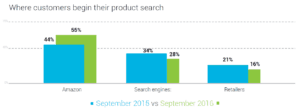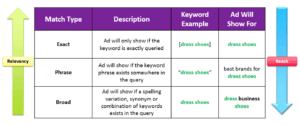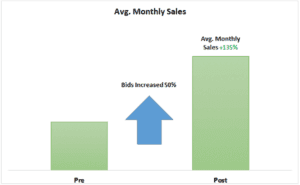
Daanish Chishti, partner, search & social director, Mindshare
If your business has an e-commerce component, chances are you’ve looked into Amazon’s paid search capability known as Amazon Marketing Services (AMS). AMS allows marketers to promote their products through different ad types on the Amazon search results page.
A BloomReach study shows that in September of this past year, 55 percent of consumers began their product search on Amazon.com vs. traditional search engines like Google, Bing, or Yahoo.
 Source: BloomReach’s State of Amazon 2016 report
Source: BloomReach’s State of Amazon 2016 report
Another 9 out of 10 consumers said they’ll comparison shop on Amazon even if they found a product they want on another retailer’s site, further reinforcing the rationale for marketers to test product promotions on AMS.

Source: BloomReach’s State of Amazon 2016 report
Based on this data, the value of a presence on AMS should be very clear to any retailer, but those already participating describe it as the Wild West of the paid search world—it is a highly competitive platform with multiple ad units and a maturing search algorithm. Compared to traditional paid search engines, AMS is still in its infancy and is growing as an advertising platform. Unless you take a strategic, yet methodical, approach, you could wind up with inefficient campaigns and lackluster results.
So, let’s talk about the ways marketers can be competitive and successful on the platform. If you want your dollars to work hard for your brand on AMS, focus on the following guidelines:
- Start off by understanding the nuances between different AMS ad types
- Build a framework that ties your Amazon Standard Identification Numbers (ASINs) to your keywords
- Implement a keyword match type mirroring approach to maximize control and performance
- Be aggressive with your bids, more aggressive than you’re used to on traditional search engines
- Test next-to-category keywords to drive incremental clicks and sales
Understanding AMS’s Different Ad Types
Before you can build your AMS strategy it’s important to understand the different ad units that are available and how each one works:

Source: Amazon Marketing Services
The consensus amongst the search community is that Sponsored Product Ads typically drive the most sales at the strongest return on ad spend (ROAS). GroupM client data shows that marketers will typically allocate over 50% of their investment towards Sponsored Products, with the rest going to Headline Search and Product Display Ads. As always, constantly test and optimize your budgets across ad types to find the mix that’s best for your business.
Tie Your ASINs to Specific Keyword Themes
Before diving into building your campaigns and understanding how you want to bid, you should take into consideration that AMS requires the support of ASINs (Amazon’s version of a product SKU) instead of just keywords. If you have multiple ASINs you’re supporting on AMS, prioritize which ones are critical to your business growth and budget for them accordingly.
Once you’ve done this you can begin to understand which keywords will support the ASINs you’ve prioritized. For traditional paid search campaigns, you’re familiar with creating a relevant experience across keyword, ad copy, and landing page. For AMS, this dynamic changes as your keywords need to be relevant to the product ASIN and the product listing/detail pages you are promoting. Keep in mind that you can have keywords support multiple ASINs and thus have more than one of your products potentially appear for Sponsored Product Ads.
It’s also extremely important to understand that when you manage an AMS program you need to familiarize yourself with the merchandising aspect of Amazon. If your ASINs are deemed unprofitable by Amazon, they can become ineligible. In this case you’d have to work with your internal merchandising team and AMS reps to get your products whitelisted in order to promote them again.
Match Type Mirroring Can Give You a Competitive Advantage
If you’re familiar with paid search, then you’re also familiar with the keyword match types Exact, Phrase, and Broad. Traditional search best practices revolve around structuring your keywords by match type in order to have the most control over budgets and bids-based performance. AMS also gives marketers the capability to break out their keyword targeting by match type.
This means that all of your top-performing, high volume keywords should be supported on each match type. A match type mirroring approach will give you a greater degree of control over your bids and give you more levers to pull when you’re optimizing on a frequent basis. Structuring your AMS campaigns in this fashion will help you understand how keywords or keyword categories perform under each match type and allow you to maximize sales and ROAS efficiency through optimizing against the data. Performance between Exact, Phrase, and Broad are going to differ by advertiser, so make sure you’re constantly optimizing and testing to find the right mix for your campaigns.

Be Aggressive With Your Bids
GroupM research has shown that for many product categories AMS’s costs-per-click (CPC) is less expensive than on Google. This means that you shouldn’t be afraid to be more aggressive than what you’re typically comfortable with when it comes to setting keyword bids.
For one client, increasing bids by 50% across the board resulted in a 135% increase in average monthly sales (the campaign included a control factor of uncapped budgets during the pre and post periods). Aside from the lift in sales, CPCs remained efficient enough that the client continued to hit their ROAS.

As always there’s no one-size-fits-all approach to keyword bidding, so you should constantly adjust, monitor, and optimize based on the CPC, Sales, and ROAS data you’re seeing. It’s also important to understand that the Amazon search results page on mobile has much more limited inventory compared to desktop, further pushing the rationale to be aggressive and capture that real estate.
Test Next-To-Category Keywords to Drive Incremental Value
Amazon had indicated that, like traditional search engines, relevancy is a key factor in when and how your ads appear for a search. Anecdotally, we’ve seen advertisers bidding on keywords that are next-to-category and still showing up in the ad results (for example, bidding on “beach sandals” and showing an ad for a beach towel). As search marketers we’ve been very focused on making sure our keywords are highly relevant to our ads and landing page, but AMS gives us a little flexibility to test next-to-category keyword targeting.
When you’re testing the limits of your comfort zone, make sure you have strict measurement and KPI comparisons to ensure that you’re achieving positive business results. Tactics like next-to-category or out-of-category keyword targeting might work for some marketers, but it will not for all. Ultimately, you want to make sure that this type of exploratory approach is driving positive business results.
In conclusion, AMS is a powerful platform that presents a tremendous opportunity for brands to grow their e-commerce business. Since the platform is young relative to the legacy search engines, it gives marketers the opportunity to test, learn, and grow. Success on AMS means combining traditional search best practices with the willingness to test outside the standards that we’re familiar with in the search world.
Mindshare is one of the media agencies within GroupM, a unit of global advertising and marketing firm WPP.
Favorite